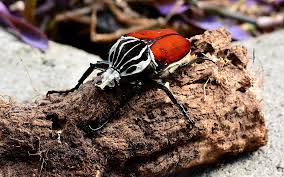- Courses
- GS Full Course 1 Year
- GS Full Course 2 Year
- GS Full Course 3 Year
- GS Full Course Till Selection
- Answer Alpha: Mains 2025 Mentorship
- MEP (Mains Enrichment Programme) Data, Facts
- Essay Target – 150+ Marks
- Online Program
- GS Recorded Course
- Polity
- Geography
- Economy
- Ancient, Medieval and Art & Culture AMAC
- Modern India, Post Independence & World History
- Environment
- Governance
- Science & Technology
- International Relations and Internal Security
- Disaster Management
- Ethics
- NCERT Current Affairs
- Indian Society and Social Issue
- NCERT- Science and Technology
- NCERT - Geography
- NCERT - Ancient History
- NCERT- World History
- NCERT Modern History
- CSAT
- 5 LAYERED ARJUNA Mentorship
- Public Administration Optional
- ABOUT US
- OUR TOPPERS
- TEST SERIES
- FREE STUDY MATERIAL
- VIDEOS
- CONTACT US
Goliath Beetles Facing Extinction
Goliath Beetles Facing Extinction
11-03-2025

- The Goliath beetles are one of the largest insects in the world. They are at risk of extinction.
- 2 species, Goliathus regius and Goliathus cacicus, are particularly threatened.
Research Findings:
- Population Decline: Goliathus cacicus has seen a decline in population, with 80% of its habitat lost in Côte d'Ivoire due to cocoa farming.
- Goliathus regius has lost about 40% of its habitat.
- Extinction Risk: Goliathus cacicus is likely extinct in certain areas like Banco Forest National Park in Côte d'Ivoire.
- This is due to both habitat loss and the over-collection of beetles for the international dried insect market.
- Insect Trade: The beetles, particularly Goliathus goliatus, are sold in large numbers in the international dried insect market, especially in southwestern Cameroon, Kenya, and Uganda.
What is the Goliath Beetle?
- Goliath beetles belong to the genus Goliathus and they can grow up to 110mm in length.
- They are found in the rainforests of countries like Sierra Leone, Liberia, Guinea, Côte d'Ivoire, Ghana, and others.
- Males have Y-shaped horns, while females do not.
- Adult beetles feed on the sap of specific tree species in mature rainforests.
Importance of Goliath Beetles
- Indicator Species: The presence of Goliath beetles shows that the forest is healthy and capable of supporting other species.
- If their population declines, it indicates a deteriorating ecosystem.
- Nutrient Cycling: Beetle larvae are omnivorous and help in recycling nutrients, which nourishes plants and other animals in the forest.
Other Threats
- Cocoa Farming: Expanding cocoa plantations in West Africa are the primary cause of deforestation affecting Goliath beetles.
- Mining and Land Conversion: These activities further reduce beetle habitats.
- Climate Change: Alters forest conditions, adding to the pressure on the beetles.
Conservation Measures
- Protect Natural Habitats: Focus on preserving rainforests in Côte d'Ivoire, Liberia, and other regions. Special attention should be given to trees where beetles concentrate.
- Involve Local Communities: Engage local communities in conservation efforts, with elders helping to identify and protect key trees. Sustainable harvesting and ecotourism can provide income while conserving the beetles.
- Regulate Cocoa Farming: There should be stricter measures to limit deforestation for cocoa plantations, especially in areas near protected forests like Taï National Park in Côte d'Ivoire.
- No Captive Breeding: Captive breeding in facilities is not scientifically supported for the survival of Goliath beetles. The focus should remain on protecting them in their natural habitat.
- Action Plan: Governments, NGOs, and scientists in West Africa should collaborate to create a coordinated conservation action plan for these species, especially Goliathus cacicus.
What is Cocoa Tree:
- Cocoa is a key plantation crop, grown primarily for the production of chocolate worldwide.
- Origin: Native to the Amazon basin of South America, it thrives in the humid tropics.
- Geographic Distribution: Cocoa trees are grown around 20° north and south of the equator, in warm, rainy regions. Major cocoa-producing regions include West Africa and South America.
Climatic Requirements for Cocoa Growth
- Altitude: Cocoa can be grown up to 300 meters above mean sea level.
- Rainfall: Requires an annual rainfall of 1500-2000 mm for optimal growth.
- Temperature:
- Ideal temperature range: 15°C to 39°C.
- Optimum temperature: 25°C.
- Soil:
- Prefers deep, well-drained soils.
- Mostly found in clay loam and sandy loam soils.
- Ideal soil pH: 6.5 to 7.0 (slightly acidic to neutral).
- Shade:
- Cocoa was evolved as an understory crop in the Amazonian forests, meaning it thrives in partially shaded areas.
- Commercial cultivation works best when 50% of the light is available, hence often grown in plantations with partial shade.
Major Cocoa-Producing Regions
- West Africa: Around 70% of the world’s cocoa beans come from four major West African countries:
- Ivory Coast
- Ghana
- Nigeria
- Cameroon
- India: In India, cocoa is mainly grown in the southern states of:
- Karnataka
- Kerala
- Tamil Nadu Cocoa is often cultivated as an intercrop alongside arecanut and coconut.
What is Plantation Crops
- Plantation crops are perennial crops cultivated extensively in large, contiguous areas in tropical and subtropical climates.
- Examples:
- Coconut
- Areca nut
- Oil palm
- Cocoa
- Cashew nut
- Tea
- Coffee
- Rubber
These crops are commercially important and are typically grown on plantations, which are large-scale farms dedicated to the cultivation of a single crop.



